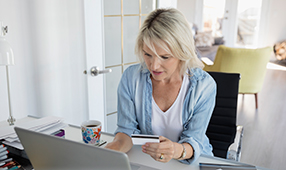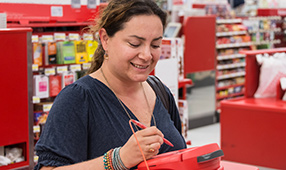It keeps getting easier and easier to pay with credit: online shopping, ride-share apps, swiping your phone at the grocery store and myriad other ways to digitally speed your transaction. And it has become more important than ever to protect the keystone of all this electronic commerce–your credit card.
Credit card fraud has become one of the most common forms of identity theft as hackers and other fraudsters steal this information to carry out transactions in your name.
“Theft, the most obvious form of credit card fraud, can happen in a variety of ways, from low-tech dumpster diving to high-tech hacking,” the Federal Trade Commission warns on its website. “A thief might go through the trash to find discarded billing statements and then use your account information to buy things. A retail or bank website might get hacked, and your card number could be stolen and shared. Perhaps a dishonest clerk or waiter takes a photo of your credit card and uses your account to buy items or create another account.”
The FTC urges consumers to treat credit card information like cash and to protect it accordingly. Here are some tips on how to do that:
Protect your physical card. Remember that despite all this electronic use, a credit card is still a piece of plastic and the first order of business is to safeguard that card.
- Sign your card to take ownership and to prevent someone else from putting their signature on the card.
- Consider a card with extra security features, like a photo ID. Card companies also are working on biometric authentication, such as fingerprints. The microchips being introduced on credit cards in the U.S. make counterfeiting more difficult, but they don’t provide significantly more security because they aren’t combined with PINs as they are in Europe.
- Don’t show your card to anyone except merchants you trust, and don’t let anyone see it when you’re out in public. Never lend your card to anyone.
- Keep an eye on your card when you use it to pay, and be sure to retrieve it before leaving.
- Carry only the cards you need, especially if you’re traveling. For extra security, keep them in a holder separate from your wallet.
- Don’t keep your PIN anywhere near the card (and obviously don’t write it on the card).
- Immediately report loss or theft of the card to the issuer. Your liability is limited to $50 on most credit cards if you report the loss promptly. More issuers are offering “zero liability” cards as well.
Protect your card remotely. Increasingly often, it is the credit card info and not the actual card that is the basis for transactions. In addition to name, number and expiration date, consumers are asked for the CVV (Card Verification Value) number, the ZIP code of the billing address and even the street address. Here’s how to protect your card information during online and phone transactions:
- Don’t provide your number or other information over the phone unless you initiated the call.
- Don’t respond to unsolicited emails even if it appears to be from your bank or other reputable source.
- Only use your card over a secure network (look for https in the URL). Don’t send your card information through email, because this usually is not secure.
- Use credit cards rather than debit cards for online transactions because they generally offer more protection, and transactions are easier to dispute.
- Shop online with established businesses only.
- Be sure to log off after completing a transaction, or shut down your browser if you can’t log off.
- Keep all your software—including browsers and virus protection—updated. Be sure your computer has a firewall and avoid conducting any transactions over public Wi-Fi. Sometimes banks or other credit card issuers will make extra online protection available.
- Make your passwords as secure as possible by using letters, numbers and symbols, and avoiding names, birthdays, anniversaries and other obvious combinations. Change the passwords frequently and don’t use the same password for all accounts. (Use a password keeper program or app to keep track of them without having to write them down.)
Protect your account information. Account management is also important. Taking care with your transactions and keeping track of them is key to avoid theft of your info and fraud:
- Be sure to cross out any unused lines on a paper receipt before signing it. Don’t sign any blank receipts. Take all receipts with you, file the important ones and tear up the ones you discard. Don’t leave receipts lying around in the open.
- Print out receipts for online transactions, or save them to your desktop.
- Consider going paperless for your account statements to avoid sending them through the mail. If you stay with paper, file the statements in a secure place or shred them before you discard them.
- Check your account statements carefully against receipts, and notify the issuer immediately of any unauthorized or suspicious entries. Check them frequently if they’re online.
- Be sure to keep your address, phone and email information up to date with your issuer.
- Keep a list of your credit card numbers, expiration dates and emergency contact numbers separate from your cards. Be sure you have that information with you when you travel for the cards you’re carrying during the trip.












